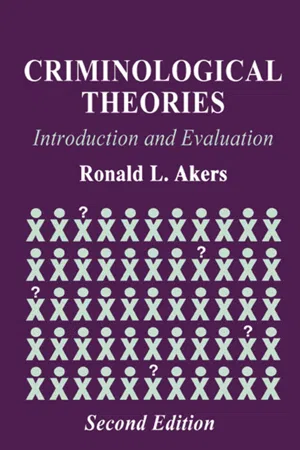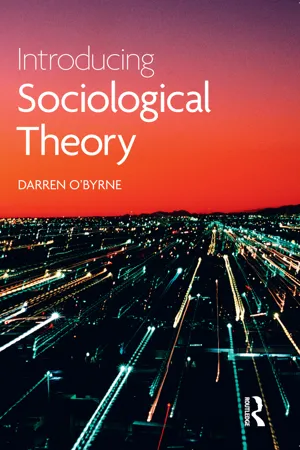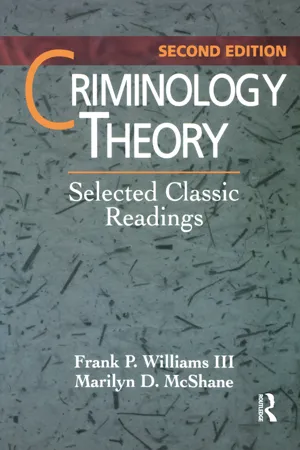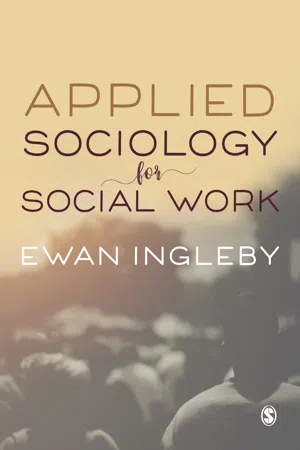Social Sciences
Consensus vs Conflict Theory
Consensus theory posits that society is held together by shared values and norms, emphasizing cooperation and stability. Conflict theory, on the other hand, views society as characterized by inequality and power struggles, with different groups competing for resources and influence. These theories offer contrasting perspectives on the nature of social order and change.
Written by Perlego with AI-assistance
Related key terms
7 Key excerpts on "Consensus vs Conflict Theory"
- eBook - ePub
- Pip Jones, Liz Bradbury(Authors)
- 2017(Publication Date)
- Polity(Publisher)
is a consensus about such things. However, it is not the kind of consensus portrayed by the consensus theorist. It is a consensus that is managed by those who believe they benefit from the subordinate position of women in society, and one that is intended to make it harder for those who do not benefit from successfully opposing the status quo.Conflict theory: conclusion
There are a number of sociological theories that can be called structuralconflict theories, in that they are based on two main premises:- social structures consist of unequally advantaged groups; the interests of these groups are in conflict, since inequality results from the domination and exploitation of the disadvantaged groups by the advantaged ones
- social order in such societies is maintained by force – either by actual force, or by force exercised through socialization.
Consensus theory versus conflict theory
Structural-consensus theory and structural-conflict theory emphasize different kinds of influences on thought and behaviour. Though both theories see the origin of human social life in structural influences or determinants of society external to the individual, they disagree about what this outside society consists of. Consensus theory emphasizes the primacy of the influence of culture – what we learn to want as a result of socialization. Conflict theory, in contrast, pays most attention to the conflict inherent in the relationship between unequally advantaged groups in society and argues that the content of culture should be seen as a means of perpetuating relationships of inequality.Society as the creation of its members
The influence of interpretation on behaviour
A third kind of sociological theory leads in a rather different direction. It still attempts to explain why human beings in society behave in the orderly ways they do, but instead of looking for the answer in the influence of a social structure which people confront and are constrained by, this theory argues something else. From this point of view, the most important influence on an individual’s behaviour is the behaviour of other individuals towards him or her. The focus is not on general cultural rules, or on the unequal distribution of advantage in whole societies. It is on the way individual social encounters work – on how the parties to them are able to understand and thereby interact with one another. This is not to say that structural theories do not try to explain this, too. In consensus theory, for example, people are role players, and act out parts learned through socialization. But how do they decide which roles to play, in which social setting? Consensus theory does not try to explain why people choose one role rather than another. It is assumed that we somehow learn to make the right choices. This third theory, however, argues that the choice of role-playing is much more complex than in this rather mechanical view. It argues that the essence of social life lies in the quite extraordinary ability of humans to work out what is going on around them – their ability to attach meaning to reality – and then to choose to act in a particular way in the light of this interpretation. This is called interpretive, or action theory - eBook - ePub
Criminological Theories
Introduction and Evaluation
- Ronald L. Akers(Author)
- 2013(Publication Date)
- Routledge(Publisher)
Chapter 8 Conflict Theory DOI: 10.4324/9781315062723-8Introduction
Conflict theory begins with the assumption that society is not held together by agreement and consensus on major values but rather is:[A] congeries of groups held together in a dynamic equilibrium of opposing group interests and efforts. The continuity of group interactions, the endless series of moves and countermoves, of checks and cross-checks…in an immediate and dynamically maintained equilibrium…provides opportunity for a continuous possibility of shifting positions, of gaining or losing status, with the consequent need to maintain an alert defense of ones positions…. Conflict is viewed, therefore, as one of the principal and essential social processes upon which the continuing on-going society depends. (Vold, 1958 :204)Power is the principal determinant of the outcome of this conflict. The most powerful groups control the law, so that their values are adopted as the legal standards for behavior. The members of less powerful groups, though they suffer legislative and judicial defeats, continue to act in accordance with their internal group norms, which means violating the law. Thus, conflict theory offers both an explanation of law and criminal justice and an explanation of criminal and deviant behavior. In the first part of this chapter, conflict theory is contrasted with consensus/functionalist theory as an explanation of law and criminal justice. In the second part, the theory that crime is produced by group and culture conflict is presented and evaluated.Law Is a Type of Social Control
Social control consists of a normative system with rules about the way people should and should not behave, and a system of formal and informal mechanisms used to control deviation from, and promote conformity to, these rules. Informal social control exists in the family, friendship groups, churches, neighborhoods, and other groups in the community. Formal social control includes law and the criminal justice system, in which the rules are officially promulgated and enforced by legally authorized agents. - eBook - ePub
- Darren O'Byrne(Author)
- 2013(Publication Date)
- Routledge(Publisher)
Conflict theoryIn this chapter we will be:- introducing the theory known as ‘conflict theory’ and seeing how it relates to the functionalist perspective we covered in Chapter 2 ;
- tracing the origins of this approach in the idea of ‘cultural relativism’;
- defining ‘interest groups’ and showing how they are central to the way conflict theorists see the world;
- discussing how conflict theorists present a relativist theory of social change in the form of a new ‘historical sociology’.
Conflict and consensus
One of the fundamental features of any sociological perspective is how it defines the ‘natural’ state of a society. Are societies inherently stable, held together by a consensus of shared values – which sometimes people lose sight of – and by smoothly integrated institutions – which sometimes malfunction? Or are they actually defined by competition and difference, occupied by a vast array of groups and communities with diverse cultures, values and interests, some of which are incompatible with one another?Functionalists, who we discussed in the previous chapter, clearly subscribe to the former position. They begin, following Durkheim, with the assumption that there is a shared value system underpinning society, and that this forms part of the same project that binds together all the institutions within that society, a benign process of social reproduction and evolution. Disagreements, conflicts, violence – these are all the result of malfunctions, and malfunctions, like diseases, can be cured. Thus, the delinquent wants to follow the same goals as everyone else, but for some reason she or he has been denied the opportunity, and so goes down a different route. This is not the route she or he wants to follow, but rather has - Carol L. Langer, Cynthia Lietz(Authors)
- 2014(Publication Date)
- Wiley(Publisher)
Social workers can easily point to the many conflicts that emerge from practice settings. Parents have conflict with a child; a child has conflict with a teacher; and a client has conflict with a department of social services. Social workers may be involved in the conflict or may be called upon to resolve the conflict. Some people avoid conflict because they think it is a distressing and unpleasant experience. For social workers, however, conflict can be a signal that change may be possible. Values and ethics guide social work practice, and social workers are required to advocate social and economic justice; they may conflict with existing social policy and service delivery systems. Social workers are sometimes called change agents. Creating and sustaining change can be uncomfortable and contentious. Social workers learn that conflict may be inevitable but can have good outcomes.This chapter discusses conflict theory. Despite the terminology, conflict theory is more of a perspective than a theory. It is a large view and can be widely applied across systems, but it does not have a step-by-step plan. Therefore, it may vary in application and is difficult to measure. Conflict theory is analytic and descriptive; its assumptions help social workers to understand what is driving a conflict. Social workers learn that conflict is more than a disagreement about a curfew or picking up dirty socks and putting them in the clothes hamper. The chapter therefore discusses the historical development of conflict theory. The theory’s key concepts and principles are discussed. Strengths and limitations of conflict theory are also identified. Finally, two case examples are provided to illustrate the theory.A Historical Discussion of Conflict Theory
Contemporary conflict theory has its roots in classical Marxism. Marx’s political economic theory, termed dialectical materialism, provides the foundation for understanding and distinguishing power differentials in relationships (Marx & Engels, 1848/1955; Marx, 1887). Marx believed that the economic form that any society used created the dynamics of all other social institutions. He thought capitalism was particularly damaging to people and institutions. A dialectic is essentially an ongoing debate. There are always at least two sides to an issue. As those perspectives are debated and act upon each other, a new debate emerges. Marx called his theory materialism because he believed that people needed to talk about real things in theoretical terms and he was discontent to leave theorizing as an abstract. Through dialectical materialism, essential assumptions of conflict theory were formed as follows: (a) conflict is inevitable, (b) there is an unequal distribution of power in relationships, (c) there is an ongoing struggle for scarce resources, and (d) whoever has the most power controls the distribution of resources, also summarized in Table 5.1- eBook - ePub
Criminology Theory
Selected Classic Readings
- Frank P. Williams III, Marilyn D. McShane(Authors)
- 2015(Publication Date)
- Routledge(Publisher)
Section V CONFLICT THEORIES
Introduction
Conflict theories are, in one sense, an extension of labeling theories. After examining the characteristics of those most likely to be labeled, some theorists concluded that the laws themselves focused on the powerless. Beginning in the mid-to-late 1960s and continuing through today, several writers contributed to analyses of the creation and application of law. Issues included the definition of crime, discrimination in the criminal justice system, and the ideological content of law. Those same issues remain current.There are so many different approaches that the only point one can be sure conflict theories share is an assumption that conflict is the natural state of human society. According to this assumption, the values of any society are established through conflict rather than through consensus. This means that groups in society are always competing against each other in an attempt to get their interests represented in major social values and institutions. These contests serve to define power in society, and those whose interests are most closely allied with law are among the most powerful.There are two major thrusts to conflict theories: one following a more radical direction and the other a more conservative track. These two thrusts are not too easily distinguished but, in general, one focuses on society itself as the basis for conflict and the other on power conflicts as part of society. The former—radical versions—are quite divergent. They are represented by Marxist, anarchist, economic determinist, value-diversity, and postmodern/constitutive theories (to name just a few general perspectives). Most commonly associated with Marxist and economic determinist positions, radical theories usually assume a sort of class war or at least a powerful elite intent on getting its own way.Crime, Ideology, and Reality
Richard Quinney’s name is synonymous with conflict theory. For a generation of graduate students in criminology, Quinney symbolized the radical critique of capitalist society. His preliminary work in the conflict approach began in 1964 with an article questioning the definitions used to create the category of crime. By 1970, he had written a quintessential work on crime (The Social Reality of Crime) - eBook - ePub
Toward a Unified Criminology
Integrating Assumptions about Crime, People and Society
- Robert Agnew(Author)
- 2011(Publication Date)
- NYU Press(Publisher)
In sum, there is evidence for the existence of both consensus and group conflict, with the degree of consensus/conflict depending on such things as the groups in question, the issue or domain being examined, the society, and the time period. Related to this, there is some support for the explanations of crime offered by both consensus and critical theorists, although most research has focused on core crimes. These conclusions may strike many as self-evident. Even a causal examination of the world reveals evidence of both consensus and conflict, and certain criminologists have come to advocate a compromise between the consensus and conflict perspectives (see Akers and Sellers, 2008; Bernard, 1983). Nevertheless, the research highlights the need for an integrated consensus/conflict theory and begins to suggest the nature of such a theory. It is beyond the scope of this chapter to develop such a theory, but in the next section I describe the issues an integrated consensus/conflict theory should address and provide some direction about how to proceed when constructing such a theory.Foundation for an Integrated Consensus/Conflict Theory of Crime
The core idea of the integrated theory is that group relations vary. There is a core consensus in all societies; the large majority of people condemn the unconditional use of personal violence and theft, and cooperate to some limited degree in the pursuit of certain shared interests-particularly protection from external and internal threats. Societies would not be possible without this consensus. Beyond that, levels of consensus and conflict vary a good deal across societies and over time. At one extreme, major groups within a society have compatible interests and values and generally “get along.” At the other, major groups have incompatible interests/values, and there is much oppression. I next discuss the groups and interests/values that should be examined in an integrated theory. I then describe the major types of group relations, focusing on conflict given its central role in causing crime. And I conclude this section by listing the factors that influence the variation in group relations, with a focus on the factors promoting conflict.Identifying Key Groups and Core Interests and Values
Which groups and values/interests should be examined in an integrated theory? Criminologists have given several answers to these questions. Subcultural deviance theorists focus on conflict between class, race/ethnic, and other groups over what behaviors are viewed as wrong (e.g., Sutherland et al., 1992; Anderson, 1999). Marxist theorists focus on conflict between class groups over economic interests (e.g., Greenberg, 1993; Lynch and Michalowski, 2006). Feminist theorists focus on conflict between males and females over gender roles and norms (e.g., Morash, 2006). Critical race theorists focus on conflict between race/ethnic groups over a range of interests and values, including economic, status, and political interests (e.g., Dillon, 2010; Gabbidon, 2010). Certain strain and related theorists focus on conflict between class, race/ethnic, gender, and age groups over issues of money, status, autonomy, and power.12 And still others focus on conflicts between groups that differ in terms of sexual orientation, religion, country of origin, position in the world system, and other dimensions; with the conflicts revolving around a range of interests and values–including those just listed.13 - eBook - ePub
- Ewan Ingleby(Author)
- 2017(Publication Date)
- SAGE Publications Ltd(Publisher)
Chapter 4 Conflict theory and social workConflict theory
Conflict theory is influenced by the ideas of Karl Marx. It is a sociological perspective that is similar to functionalism, with its focus on the social system. Conflict theory is different to functionalism due to the importance that is placed on economics. The perspective explores the material circumstances that produce conflict within social systems. Taylor et al. (2004, p15) emphasise the importance of the concept of ‘ideology’ to conflict theory. Ideology is produced by beliefs and values which are regarded as being based on material circumstances, and is considered to support the values of the rich and powerful sectors of social groups as opposed to the social system’s poor and powerless.Marx is associated with conflict theory and he was especially interested in those aspects of the social system that appear to be contradictory. He also talked about the terms ‘infrastructure’ and ‘superstructure’. Whereas the infrastructure relates to all tangible aspects of the economic system, the superstructure corresponds to systems of belief and the ideas that are generated from these beliefs. According to Marx, the economic infrastructure has a critical influence on the beliefs and ideas of the superstructure. He draws attention to the importance of social classes. The traditional Marxist emphasis is placed on the existence of two main social groups: a ruling class and a subject class. The contradictory circumstances of these two social classes form the basis of conflict within society according to conflict theorists, and Marx argues that there are a series of fundamental contradictions within capitalist societies. This interest in contradictions links Marx’s philosophy to the work of Georg W. F. Hegel, and the exemplification of such contradictory relationships can be seen in the traditional working arrangements for factories. In contrast to the workers who are traditionally regarded as being ‘on the factory floor’, the factory manager is usually based in a private office. Another example of a contradictory relationship occurs with private ownership: a few powerful individuals own companies, whereas the majority of the population own very little in comparison. Marx argues that these contradictions in society are the basis of instability and conflict. This is the rationale behind the prediction that a revolution will occur within capitalist societies that will lead to a redistribution of wealth and the establishment of a communist society. Marxism is a profound and complex social theory. As noted previously, the emphasis on ‘conflict’ can be traced back to the influence of Hegel’s philosophical idea of a ‘thesis, antithesis and synthesis’ being present within the social world (Audi 1999). It is acknowledged that a social revolution will only occur when the working class become fully aware of the unfair contradictions that exist within the social system. The argument runs that, until this realisation occurs, the social system is likely to survive because of the ‘false consciousness’ of the working class. It is only when the working class become fully aware of the implications of social contradictions and of the need to replace the existing social order with a communist society that a social revolution will occur.
Learn about this page
Index pages curate the most relevant extracts from our library of academic textbooks. They’ve been created using an in-house natural language model (NLM), each adding context and meaning to key research topics.






